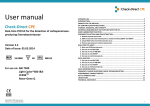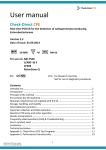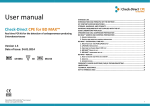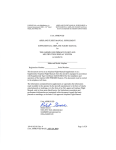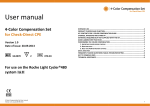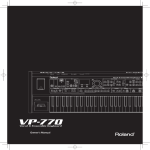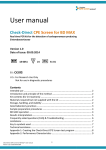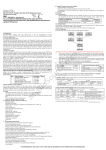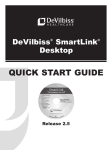Download User manual - Check
Transcript
User manual Check-Direct CPE Real time PCR kit for the detection of carbapenemase carbapenemaseproducing Enterobacteriaceae Version 1.2 Date of issue: 05.09.2013 18-0080 48 For use on: ABI 7500 Light Cycler®480 I&II CFX96TM Rotor-Gene Q Check-Direct CPE User manual Version 1.2 , Issued 05-09-2013 080-03 INTENDED USE ................................................................ ....................................................................................2 INTRODUCTION................................................................ ...................................................................................2 PRINCIPLE OF THE METHOD ................................................................................................2 ................................ KIT CONTENTS (FOR 48 REACTIONS) ...................................................................................2 ................................ STORAGE, HANDLING, AND STABILITY ................................................................................2 ................................ MATERIALS REQUIRED BUT UT NOT SUPPLIED WITH THE KIT...................................................3 GOOD LABORATORY PRACTICES .........................................................................................3 ................................ SPECIMEN COLLECTION AND DNA EXTRACTION..................................................................4 1. HUMAN SPECIMEN COLLECTION .............................................................................................. ................................ 4 2. DNA EXTRACTION FROM PERIANAL/RECTAL SWABS WITH NUCLISENS® EASYMAG® ...................... 4 3. POSITIVE AND NEGATIVE CONTROL PREPARATION ...................................................................... 4 REAL-TIME PCR ASSAY ........................................................................................................4 ................................ 1. REAL-TIME PCR REACTION SETUP ........................................................................................... ................................ 4 2. FOR USE ON THE ABI 7500 ................................................................................................... ................................ 5 3. FOR USE ON THE LC®480 I&II ............................................................................................... ................................ 5 4. FOR USE ON THE CFX96™ ..................................................................................................... ................................ 5 5. FOR USE ON THE ROTOR-GENE Q............................................................................................ ................................ 5 DATA ANALYSIS ................................................................ ..................................................................................6 1. FOR USE ON THE ABI 7500 ................................................................................................... ................................ 6 2. FOR USE ON THE LC®480 I&II ............................................................................................... ................................ 6 3. FOR USE ON THE CFX96™ ..................................................................................................... ................................ 7 4. FOR USE ON THE ROTOR-GENE Q............................................................................................ ................................ 7 DATA INTERPRETATION ......................................................................................................8 ................................ FREQUENTLY ASKED QUESTIONS STIONS (FAQ) & TROUBLESHOOTING TROUB ..........................................8 PERFORMANCE CHARACTERISTICS ......................................................................................9 ................................ KEY TO SYMBOLS USED ..................................................................................................... ................................ 10 LIMITATIONS ................................................................ .....................................................................................11 TECHNICAL ASSISTANCE .................................................................................................... ................................ 11 1 Intended use Principle of the method Check-Direct Direct CPE is a qualitative in vitro diagnostic test for the rapid detection of carbapenemase genes directly from perianal and rectal swabs. Check Check-Direct CPE detects the presence of the carbapenemase genes KPC, NDM, VIM, and OXA-48 48, presently the primary cause of carbapenemase production in Enterobacteriaceae.. The assay is performed on an automated real-time PCR instrument using perianal/rectal swabs from individuals at risk of colonization with carbapenemase-producing Enterobacteriaceae.. Check Check-Direct CPE can be used as an aid to identify, prevent and control carbapenemase carbapenemase-producing Enterobacteriaceae that colonize patients in healthcare lthcare settings. Check Check-Direct CPE is not intended to diagnose infections with carbapenemase-producing Enterobacteriaceae nor to guide or monitor treatment for these infections. Parallel cultures are necessary to recover organisms for epidemiological typing, g, susceptibility testing and for further confirmatory identification. Check-Direct CPE assay is based on specific sp recognition and amplification of target sequences by PCR, and the simultaneouss detection de of the accumulation of PCR amplification products by fluorescent DNA probes. A control DNA molecule, molecule the internal control, is added to the clinical specimen prior to DNA extraction extr to monitor that DNA extraction and PCR amplification were successful. Five molecular olecular beacon probes, labeled with 4 different dyes are used to detect the various carbapenemases and the control DNA. Check-Direct CPE discriminates between KPC, NDM/VIM, and OXA-48. OXA For each of the 4 carbapenemase genes, KPC, OXA-48, NDM and VIM, many any gene variants exist. PCR primers and fluorescent probes of Check-Direct Direct CPE are selected to target homologous gene segments segmen of these carbapenemase genes, and in this way gene variants are reliably detected. Introduction The worldwide emergence and dissemination of carbapenem resistance among Enterobacteriaceae is a serious threat to public health. These organisms are associated with high mortality rates and have the potential to spread widely. The most common cause of carbapenem resistance in Enterobacteriaceae is the expression of carbapenemases, i.e. Carbapenemase-Producing Enterobacteriaceae or CPE. CPE have elevated or complete resistance to carbapenems and most other β-lactam lactam antibiotics. Presen Presently, the vast majority of CPE are associated with the presence of one of the following plasmid plasmid-encoded carbapenemases: KPC (Klebsiella pneumoniae carbapenemase), VIM (Verona integron– encoded metallo-β-lactamase), NDM (New Delhi metallo-β-lactamase) lactamase) or OXA OXA-48 (Oxacillinase-48). Moreover, CPE often have other non–β-lactam lactam resistance determinants resulting in multidrug- and pandrug-resistant isolates. Patients usually carry CPE by colonization of the colon. Therefore, rectal swabs provide a proper specimen to assess carriage of CPE, and perianal swabs may be used as a non noninvasive alternative. Check-Direct CPE is a rapid real-time time PCR test for the detection and discrimination of KPC, NDM/VIM, and OXA-48 in rectal and perianal specimens. - Check-Direct CPE User manual Version 1.2 , Issued 05-09-2013 Kit contents (for 48 reactions) reactions Components (Mat. No.) Description Storage conditions CPE PCR Mastermix (9-0080) 1 transparent tube and cap 630µl + 4°C CPE solution (9-0071) 1 brown tube (purple inlay ) 140 μl Internal control (9-0077) 1 tube (red inlay ) 300 μl Negative control (9-0070) 1 tube (white inlay ) 100 µl KPC positive control (9-0073) 1 tube (green inlay ) 100 μl NDM positive control (9-0075) 1 tube (gold inlay ) 100 μl VIM positive control (9-0074) 1 tube (yellow inlay ) 100 μl OXA-48 positive control (9-0076) 1 tube (orange inlay ) 100 μl Manual (9-0078) Leaflet – download from website - 20°C, store in the dark Not critical Storage, handling, and stability Check-Direct CPE reagents are shipped cooled. cooled The CPE PCR Mastermix should be stored at +4°C upon receipt. All other reagents should be stored at -20°C upon receipt. Please visually inspect the box upon initial opening to ensure that its contents are intact. Check-Direct CPE solution should ld not be exposed to more than 12 freeze-thaw cycles. Please contact the Check-Points office at [email protected] points.com if you have any further questions. Store kit reagents at indicated temperature until expiration date. date 2 Materials required but not supplied with the kit Prevention of contaminations Use separate rooms: a pre-PCR PCR room and a post-PCR post room. Supplies • • • • • • • • • • • Equipment NucliSENS® easyMAG® Extraction kit (bioMérieux, France) Swabs for rectal and perianal specimen collection and transport (example: Sigma-transwabs (Medical Wire & Equipment, UK) or Eswab™(Copan Diagnostics, US) in Amies transport media). Disposable laboratory (powder-free) gloves Lab coat Pipettes & disposable (filter-) tips for volumes of 1 to 1000 µl 1.5 ml tubes (“Eppendorf tubes”) 96-well PCR clear plate for use on ABI7500 96-well PCR white plate for use on CFX96™ and LightCycler®480 PCR plate seal PCR strip tubes and caps 0.1ml (QIAGEN,US) For use on the LightCycler®480: the 4-Color Compensation Set (Ref: 18-0070, Check-Points Health B.V., NL) • • • • • • NucliSENS® easyMAG® Extraction platform ((bioMérieux, France) Real--time PCR instruments: ABI7500 (Applied Biosystems, US) LightCycler® LightCycler®480 I&II (Roche, CH) CFX96™ (Bio (Bio-Rad, US); Rotor Rotor-gene Q 5plex (QIAGEN, US) Rotor Rotor-disc 72x0.1ml wells, locking Ring 72 72-Well Rotor, and loading block 72x0.1ml tubes (QIAGEN, US) Vortex mixer mini centrifuge Plate centrifuge • • • DNA extraction and preparation ation of the amplification reactions are carried out in the pre-PCR room. Incubation in the real-time PCR thermocycler is carried out in the post-PCR post room. Never transfer items from the post-PCR post room to the pre-PCR room. To keep laboratory free of PCR product contamination: • • • • • • • Use pipettes with hydrophobic filter tips. Make sure to always use a new pipette tip when adding solutions, test samples, and controls to wells of a 96-well well plate. Follow proper pipette-dispensing dispensing techniques to prevent aerosols. Wear clean disposable gloves and nd clean lab coats for the different steps of the test. Change gloves whenever you suspect that they are contaminated. Keep the tubes of all kit components and samples closed as much as possible. Clean the lab benches and all equip quipment regularly with a 0.5% sodium hypochlorite solution. Good laboratory practices Recommendations for best results • • • • • • The test must be performed by adequately trained personnel. Do not use reagents after their expiration date. Before use, thaw frozen reagents completely at room temperature and vortex briefly to obtain a homogeneous solution. After vortexing briefly, spin down the solution to avoid contamination when opening the cap. Follow recommendations for storage, handling and freeze--thaw cycles to preserve the quality of the kit’s reagents. Protect reagents from light to avoid photo-bleaching bleaching of the dyes. Periodically, verify the accuracy and precision of pipettes, as well as correct functioning and calibration of the instruments. Check-Direct CPE User manual Version 1.2 , Issued 05-09-2013 Users are strongly advised advis to read the full protocol before starting the test 3 • Negative control(s) Use the negative control () provided in the kit as a sample to validate the run. The negative control contains the internal control. We also recommend performing a DNA extraction as specified earlier, with the internal control solution using a sample known to be negative for the test in use (i.e., ( carbapenemase negative sample, or elution buffer). Specimen collection and DNA extraction 1. Human specimen collection In order to obtain adequate specimen, the procedure for specimen collection must be followed carefully with adequate swab material (see section Materials required but not supplied with the kit). 1. Collect perianal/rectal specimen according to local guidelines and swab swabs’ manufacturer recommendations. 2. Place swabs in their containers,, containing 1 ml of liquid transport m medium. 3. Label the containers. 4. Refer to the swab manufacturer instruction for storage, handling, and stability. 2. DNA extraction from perianal/rectal /rectal swabs with NucliSENS® easyMAG® Real-time PCR assay Important points before starting: • Preparation of the real-time time PCR reactions is carried out in the pre-PCR pre room. • Specific parameters and materials should be used for each type of real-time real PCR instrument use to perform the test. • Targets are detected in the FAM, VIC, and TexasRed channels. The internal control is detected in the Cy5 channel. Important points before starting: DNA extraction is carried out in the pre pre-PCR room. 1. Real-time PCR reaction setup Procedure: Direct CPE has been validated with the NucliSENS® easyMAG® automated DNA 1. Check-Direct extraction procedure for perianal/rectal swabs in transport medium. Follow the protocol Generic 2.0.1 from the manufacturer for perianal/rectal rectal swabs. 2. Use 200 µl of perianal/rectal swab fluid from each specimen and add 5 µl of the internal control solution (IC solution, ) to each well of the easyMAG® cartridge. Start the DNA extraction using the Generic extraction protocol. 3. DNA is eluted in 70 µl elution buffer. 4. DNA extracts can be stored at +4°C for up to 6 months, and at --20°C for a longer period of storage. time PCR assay or store as 5. Use the DNA solution directly and continue with the real-time specified until use. 3. Positive and negative control preparation To validate the run, perform positive and negative control reactions for each Check Check-Direct CPE PCR run. The positive and negative controls are supplied with the kit. • Positive control(s) Test the relevant positive control(s) provided in the kit.. Positive controls contains the internal control. Check-Direct CPE User manual Version 1.2 , Issued 05-09-2013 1. 2. 3. 4. 5. 6. 7. 8. 9. Calculate the number of reactions. Thaw Tha reagents, mix well, spin down and keep on ice. Prepare the real-time time PCR (qPCR) reaction mix as described in Table 1. Multiply the CPE solution and the CPE PCR Mastermix ix by the right number of samples and include 10% surplus to ensure that you have enough eno qPCR reaction mix for all the calculated reactions. Pipette 15 µl of qPCR reaction mix to the wells well of the 96-well plate. Pipette 10 µl of each test sample to the wells of the 96-well plate previously filled with 15 µl of qPCR Mastermix mix (see Table 2). Pipette 10 µl of positive control (solution(s) KPC (), NDM (), VIM () and/or OXA-48 ()) to the well of the 96-well plate ate previously filled with 15 µl of qPCR reaction mix (Table 2). Pipette 10 µl of negative control solution () to the well of the 96-well plate previously filled with 15 µl of qPCR reaction mix (Table 2). Seal the plate, or close the tubes. Mix M the plate by tapping it on the bench and spin down briefly. Transfer the plate to the post-PCR PCR room. Without delay,, place the plate into the real-time real PCR instrument and start the run with the parameters corresponding to the real-time real PCR instrument in use (see next points). When the run is completed, discard the plate according to local regulations. 4 10. Following the manufacturer’s instructions for each real-time time PCR instruments, start and set up the run using the parameters specified in Table 3 and 4,, and in the text below. 2. For use on the ABI 7500 • • • • • • • Run mode: Standard 7500 Reaction volume: 25 μl ROX™ passive reference dye: Included in the qPCR Buffer TaqMan® Reagents Experiment: Quantitation – Standard Curve Standard ramp speed Targets: Reporter Dyes and Quencher setup, see Table 3. 3. For use on the LC®480 I&II To use the Check-Direct CPE real-time time PCR kit on the LightCycler®480 system I&II, a 4-color compensation object is required and generated by using the 4-Color Color Compensa Compensation Set supplied by Check-Points Health B.V. (Ref: 18-0070). • Detection format LC®480 I: Multi Color Hydrolysis Probe • Detection format LC®480 II: 4 color FAM VIC/HEX RED610 CY CY5 • Filter Combination Selection: see Table 3. • Reaction Volume: 25 µl • Analysis mode: Quantification for the amplification step • Integration time mode: Dynamic • Color compensation object or file required 4. For use on the CFX96™ • • • • • Sample Volume : 25 μl Temperature Control Mode : Calculated Scan Mode: All channel Plate type: BR white Plate Setup: View/Edit Plate and Select Fluorophore as described in Table 3 5. For use on the Rotor-Gene Q • • • Reaction Volume : 25 μl 72-well rotor selected Gain settings: Green 6 / Yellow 4 / Orange 3 /Red 8. Check-Direct CPE User manual Version 1.2 , Issued 05-09-2013 Table 1: qPCR reaction mix setup. Component Volume per reaction CPE PCR Mastermix 12,5 µl CPE Solution () 2,5 µl Total volume 15 µl Table 2: Real-time PCR sample setup. Reaction Type Component Volume per reaction Test sample Sample DNA 10 µl Positive control KPC (), NDM (), VIM (), ), OXA-48 OXA () 10 µl Negative control Negative sample or negative control provided () 10 µl Table 3: Real-time PCR setup. Target ABI 7500 Detector LC®480 I Detector LC®480 II Detector KPC FAM FAM (483-533) FAM (465-510) FAM NDM, VIM VIC OXA-48 TexasRed (TXR) Internal Control (IC) Cy5 VIC/HEX/Yellow555 VIC/HEX (523-568) (533-580) Red610 Red610 (558-610) (533-610) Cy5 Cy5 (615-670) (618-660) CFX96™ Detector Rotor-Gene Q Detector Reaction Volume Per Well Green (510±5) VIC Yellow (557±5) TexasRed (TXR) Orange (610±5) Cy5 Red (660±10) 25 µl Table 4: Real-time protocol parameters. Data Collection Ramp Rate Mode Step Temperature Time Cycles 1: 50°C 2 min 1 OFF standard 4.4°C/s 2: 95°C 10 min* 1 OFF standard 4.4°C/s 3: 4: 95°C 60°C 15 sec 60 sec 45 Plate read Optics on standard 4.4°C/s 2.2°C/s ABI 7500 /CFX96™/ LC®480 Rotor-Gene Q I&II 3 or 10 min can be used for denaturation time depending on other assays to be run *3 simultaneously with the the Check-Direct CPE test. 5 Data analysis Important points before starting: • For a detailed description on how to operate real-time time PCR instruments and how to analyze data, please refer to the real-time time PCR instrument instruction manual. • Always visually inspect the amplification plot for each sample tested versus CT values obtained with the software. 1. For use on the ABI 7500 1. 2. 3. 4. Analyze data using ROX as a passive reference. In the Options setting, for each Target (see Table 3), deselect the box for auto threshold and auto baseline as shown in Figure 1 (red circle) and select Reanalyze. Set the threshold manually in the Analysis settings window for each detector channel using the threshold values recommended in Table 5. Check amplification plots versus CT values calculated by the software for each target. 2. For use on the LC®480 I&II 1. 2. 3. 4. 5. nd Select Abs Quant/2 Derivative Max analysis (Figure 2). Analyze the data using the color compensation object application-specific to the Check-Direct Direct CPE assay previously created. Select Color Comp (On) – In database select the CC object (Refer to Check-Points Points User Manual for the 4-Color Compensation set, Ref: 18-0070). Select the High Sensitivity option and Calculate Cp values for each filter combination. For or each filter combination, always check amplification plot versus Cp values. In the results table, check Cp values for each targets versus the Status given by the software (red= positive; green= negative; blue= call uncertain). Validate the Status of the sample using the software by visually inspecting amplification curves (Figure 2). Figure 2: Screen shot of a typical analytical window on the LC®480 system I with the LC®480 software v1.5 Amplification plot of positive and negative samples for the Check-Direct Check CPE test (linear scale); threshold is automatically calculated by the software (Table 5). Table 5: Recommended threshold settings. Figure 1: Screen shot of a typical analytical window on the ABI7500 with ABI7500 software oftware v2.0.6 Amplification plot of positive and negative samples for the Check-Direct Direct CPE test (logarithmic scale); Red circle: deselect the box of auto Threshold/Auto baseline. Check-Direct CPE User manual Version 1.2 , Issued 05-09-2013 Detector Target CFX™96 Rotor-Gene Q FAM - green KPC ABI 7500 0.002 LC®480 I&II I Auto-calculated calculated 60-150 0.02 VIC - yellow NDM- VIM 0.001 Auto-calculated calculated 200-250 0.015 TXR - orange OXA-48 0.006 Auto-calculated calculated 400-800 0.03 Cy5 - red IC 0.003 Auto-calculated calculated 40-100 0.06 6 3. For use on the CFX96™ 1. 2. 3. Open the Data file for Data Analysis. In the Analysis Settings use the following parameters: • Analysis Mode : Fluorophore • Baseline Setting : Baseline Subtracted Curve Fit; Apply Fluorescent Drift Correction • Cq Determination : Single Threshold • Baseline Method : Auto Calculated • Cycle to Analyze: 10-45 • Baseline Threshold: User defined (to be set per fluorophore) Set the threshold manually for each detector channel using the threshold values recommended in Table 5 Check amplification plots (in the Quantification Tab) versus Cq values calculated by the software for all targets in the results table. 4. For use on the Rotor-Gene Q 1. 2. 3. 4. Open the data file. Open the raw channel page for each detector. Select Options and Crop start cycles. In the pop-up up window Remove data before cycle, enter “15” and select “OK”. Then, use the parameters indicated in Table 6 to analyze each detector channel. Set the threshold manually for each detector channel using the value recommended in Table 5. Check amplification plots versus Ct values calculated by the software for each target in the Quant. Results table. Table 6: Rotor-Gene Q analytical parameters Detector / TARGET Dynamic Tube Slope Correct Outliners Removal 10% Eliminate Cycles before: 15 Green / KPC ON ON Yellow / NDM-VIM ON ON 6% 15 Orange / OXA-48 ON ON 10% 15 Red / IC ON ON 15% 15 Figure 3: Screen shot of the typical analytical window on the CFX96™ with the CFX96™ ssoftware v2.0 Amplification plot of positive and negative samples for the Check-Direct Direct CPE test (logarithmic scale); Adjus Adjust threshold manually using the threshold bar on the amplification plot; (Blue: FAM signal). Figure 4: Screen shot of the typical analytical window with the Rotor-Gene Rotor Q software v2.1.0 (Build 9) Amplification plot of positive and negative samples for the Check-Direct Check CPE test (logarithmic scale) in the Green channel. Check-Direct CPE User manual Version 1.2 , Issued 05-09-2013 7 Data interpretation Frequently asked questions (FAQ) & Troubleshooting 1. 1. May other specimen preparation and DNA extraction methods be used with CheckCheck Direct CPE? Check-Direct CPE test has been optimiz imized using specific swabs and transport medium in combination with the NucliSENS® easyMAG® extraction methods. Check-Points Check does not guarantee the performance of the test with methods other than those recommended in this manual. 2. The real-time results show no CT/CP/Cq values or interpretation indicating that the sample is invalid. Possible causes and troubleshooting: • The sample DNA was not added to the assay. • The sample DNA tested with Check-Direct Check CPE is negative and the internal control was not added prior to DNA extraction. Please repeat the DNA extraction. • The DNA extraction failed since the internal control was not n detected. Please repeat the DNA extraction. • The sample DNA contains contami taminants inhibiting the reactions. Please repeat the DNA extraction. • CPE Solution or CPE PCR Mastermix was not added to the assay. Please repeat the test. • Reagent solutions are degraded aded or may have expired. expired 3. The real-time time results show no CT/CP/Cq values for the positive control or interpretation indicating that sample is invalid. Possible causes and troubleshooting: • The positive control solution was not added. Repeat the test. • CPE Solution or CPE PCR Mastermix was not added to the assay. Please repeat the test. • Reagent solutions are degraded or may have expired. 4. Troubleshooting for invalid result. Repeat the test using the same DNA extract. If invalid results persist, repeat the test by preparing a new DNA extract from the original specimen. Alternatively, repeat the test with a new DNA extraction from a newly collected specimen. Run validation: Table 6 Check the positive and negative control amplification curves. Valid run report reports: • • • 2. No instruments system failures during the run. Negative control with a CT value of 30 ±3 in the Cy 5 detector channel and no CT value in the other detector channel. Positive control CT values as expected in Table 6. The exact CT values of the positive controls vary depending on the qPCR instruments used and the threshold settings. Results interpretation: Table 7 If the run is valid,, interpret results as positive, negative or invalid with the CT values obtained for the samples with the guidelines summarized in Table 77: • Positive carbapenemase samples will show a CT value in the FAM, VIC and/or Red(TXR) channel. Positive carbapenemase samples will also show a CT value in the Cy5 channel if the target has not out competed the internal control (IC) for the resources during the reaction. • Negative carbapenemase samples will show no CT value in the FAM, VIC, and Red(TXR) Channel. In the Cy5 Channel, a CT value is expected at 30 ±3. • Samples with a FAM, VIC and/or Red(TXR) CT undetermined or N/A, and with a Cy5 IC showing no CT value or a CT ≥33 mean that the sample is invalid, see FAQ and Troubleshooting 3 to7. Table 6: Criteria for a valid run with Check-Direct CPE test*. Instrument KPC FAM - green NDM VIC - yellow VIM VIC - yellow OXA-48 Red(TXR) – orange IC Cy5 – red Positive control ABI7500, CFX™96, Rotor-Gene Q 25 ±3 29 ±3 26 ±3 24 ±3 30 ±3 Positive control LC®480 I&II 28 ±3 30 ±3 27 ±3 26 ±3 30 ±3 FOR ALL N/A N/A N/A N/A 30 ±3 Sample Type / Expected CT values Negative sample (extracted with IC) Table 7: Data interpretation guidelines*. KPC, NDM/VIM, OXA-48 CT values IC CT values Interpretation YES YES or N/A Positive sample N/A 30 ±3 Negative sample N/A N/A or ≥33 Invalid * If observed CT values vary significantly from expected CT values , see FAQ and Troubleshooting section Check-Direct CPE User manual Version 1.2 , Issued 05-09-2013 8 5. 6. Real-time time results show very low fluorescent signals in all samples and detector channels, including the internal control signal. Possible causes and troubleshooting: • The CPE solution containing the fluorescent probes and primers is degraded. Please check expiration date, the number of thaw/freezing cycles that the CPE solution tube has undergone, and if the kit was stored correctly. • The real-time time PCR system may be responsible for these results. Please refer to instrument User’s manual or contact your real-time time PCR instrument local representative. CT/CP/Cq values troubleshooting. • Samples with very low CT values and no amplification curves. The manual threshold is too low. Samples showing a CT value <15 and no amplification curve are considered negative. The observed CT value is an artifact of the software analysis: the threshold crosses the background nd noise of the curve. • Invalid Run: CT values expected for the controls in Table 6 do not match the CT values observed In the experiment. Check that these ese differences are not due to the threshold being too high or too low.. If changing the threshold d does not improve the results, go to FAQ 3. to 6. Performance Characteristics 1. Analytical sensitivity The analytical limit of detection (LOD) of Check-Direct Check CPE real-time PCR test was assessed for four carbapenemase genes assoc ssociated with carbapenemase production in Enterobacteriaceae:: KPC, NDM, VIM, and OXA-48. OXA No quantified genomic standards for these hese markers were available at the time, therefore the analytical sensitivity test was performe rmed using plasmid having a 400 bp target sequence DNA fragment. Thus, the LOD of the Check-Direct Check CPE real-time PCR test was established using plasmid DNA directly in the PCR reaction reac mix. To determine analytical sensitivity, an end-point dilution was used until the assay ssay could no longer detect the target in question in more than 5% of the replicates. Results: See Table A. Table A Target 7. 8. 9. The real-time PCR instrument gives an error message. time PCR instrument user manual or contact the local technical Refer to the real-time support of the real-time PCR instrument company. I left Solutions (CPE, Internal control, negative, or positive control) out of the -20°C (4˚F) storage. These reagents must be stored at -20°C (-4°F) 4°F) for proper performance of the test. The performance of the product cannot be fully guaranteed if these solutions were left out of -20°C (-4˚F) for more than 24 hours. Direct CPE test did not yield identical results. Duplicate samples tested with Check-Direct CT (CP/Cq) values of identical samples may vary between individual reactions. Large variations, > 2 CT values, suggest pipetting errors rors or other differences between the duplicate samples. 10. Data Analysis and Interpretation. If you encounter difficulties with the data analysis and interpretation please contact Check-Points Technical Support at [email protected]. Check-Direct CPE User manual Version 1.2 , Issued 05-09-2013 LOD (copies/PCR) KPC 5 NDM 5 VIM 5 OXA-48 5 2. Specificity 2.1 In silico Specificity The specificity of the Check-Direct Direct CPE real-time real diagnostic test is ensured by the selection of the correct primers and probes, as well ell as the selection of stringent reaction conditions. Primers and probes sequences were validated with in silico analysis. Primers and Probes sequences were designed igned to specifically identify the gene variants listed in Table B. Primers and Probes sequences were tested forr potential po homologies with all the gene sequences published by the international gene bankk (GenBank®, (G NIH genetic sequence database) using sequence comparison analysis. oth organisms for designed primers and Results: No cross homology was found with other probes 9 Table B Gene ped correctly for the targeted carbapenemase genes Results: All 93 bacterial strains were typed with the Check-Direct CPE test. Variants KPC 1 to 15 NDM 1 to 8 VIM 1 to 6, 8 to 37 OXA 48, 162, 163, 181, 204, 232, 244, 245. Table D # 2.2 Analytical Specificity The experimental specificity of the Check-Direct CPE real-time time diagnostic test was determined by testing the cross-reactivity reactivity with samples containing non non-target organisms. 132 carbapenemase-negative negative strains were used to test the specificity of the Check Check-Direct CPE real-time test, see bacterial strains listed in Table C. Check-MDR CT103 Check-Direct Direct CPE 19 KPC KPC 16 NDM NDM/VIM 1 NDM+OXA-48 NDM/VIM+OXA--48 33 VIM NDM/VIM 1 VIM+OXA-48 NDM/VIM+OXA--48 23 OXA-48 OXA-48 Results: All isolates tested negative with the Check-Direct Direct CPE assay and the internal control was detected in all samples. The Check-Direct Direct CPE test showed 100% specificity based on the reference strains tested. Key to symbols used Table C Organisms # Organisms # Citrobacter freundii 5 Enterococcus faecalis 2 Campylobacter jejuni 2 Klebsiella oxytoca 1 Enterobacter aerogenes 1 Klebsiella pneumoniae 16 Enterococcus casseliflavus 1 Pseudomonas aeruginosa 2 Enterobacter cloacae 42 Staphylococcus aureus 2 Escherichia coli 51 Salmonella thypimurium 1 Pseudomonas mirabilis 3 Stenotrophomonas maltophilia 2 Serratia marcescens 1 For In Vitro Diagnostic Use Negative control Catalog number KPC positive control Batch code VIM positive control IFU number NDM positive control OXA-48 positive control CPE solution Internal control Temperature limitation CPE PCR Mastermix Use before YYYY-MM 3. Analytical Reactivity Contains sufficient for < n > tests To evaluate the analytical reactivity, a retrospective study was performed with 93 bacterial strains of 26 different gram-negative species (Table D).. The 93 bacterial strains tested with Check-Direct CPE were previously identified carbapenemase-positive positive with the micro micro-array diagnostics test Check-MDR CT103 (Check-Points Heatlth). Check-Direct CPE User manual Version 1.2 , Issued 05-09-2013 Manufacturer Consult instructions for use 10 Limitations Check-Direct CPE is a DNA-based real-time time PCR assay to detect the presence of the carbapenemase genes KPC, NDM, VIM, and OXA-48 in Enterobacteriaceae Enterobacteriaceae. The test detects the following carbapenemase gene variants: blaVIM1-6;8-34;blaOXA-48-162 162-163-181-232-244-245;blaNDM1-8 and blaKPC1-15. KPC, NDM, VIM, and OXA-48 48 represent the clinically most prevalent carbapenemases in Enterobacteriaceae in most parts of the world. However, other rare carbapenemases may also be responsible for carbapenemase penemase production in Enterobacteriaceae and these are not detected by Check-Direct Direct CPE. Carbapenem resistance is caused by carbapenemase production, but also by various other mechanisms. A negative result with Check-Direct Direct CPE does not imply that the bac bacterium is not carbapenem resistant; it implies that the bacterium is not likely to carry any of the carbapenemase gene variants of KPC, NDM, VIM and OXA-48 48 detected by Check Check-Direct CPE. Therefore, the test result of Check-Directt CPE should never be used as guidance for therapy. The quality of the input DNA is an important factor for obtaining reliable results with Check CheckDirect CPE. DNA must be extracted from perianal or rectal swabs in transport medium using the NucliSENS® easyMAG® DNA extraction system (bioMérieux, bioMérieux, FR FR). Other DNA extraction systems have not been approved for use with Check-Direct Direct CPE yet. The assay has been validated for both Sigma-transwabs transwabs (Medical Wire & Equipment, UK) and Eswab™(Copan Diagnostics, US) in Amies transport media. Other swab types are also expected to work well but this has not been validated yet. Technical assistance [email protected] +31 317 453 908 Despite the utmost care in the development and preparation of the protocol Check-Points Check cannot take any responsibility for errors, omissions and/or future changes herein. Literature Citation:: When describing a procedure for publication using this product, please refer to it as the CheckDirect CPE. Notice to Purchaser: This product is sold under license from PHRI Propertie erties and may be used under PHRI Properties patent rights only for human in vitro diagnostics, food testing, veterinary testing, or research. Trademarks TaqMan® is a registered trademarks of Roche Molecular Systems, Inc. Sigma-transwabs transwabs is a registered trademarks of Medical Wire & Equipment Eswab is a registered trademarks of Copan an Italia S.p.A. ABI, FAM, VIC, ROX are registered trademarks of Applera App Corporation or its subsidiaries in the US and/or certain other countries. Red610 is a registered trademark of Biosearch Technologies, Inc Cy5 is a registered trademark of Amersham Biosciences sciences Ltd NucliSENS® easyMAG® is a registered trademark of bioMérieux The assay has been tested extensively with samples containing various gram gram-negative bacteria, such as Escherichia, Salmonella, Klebsiella, Enterobacter Enterobacter, Citrobacter and Pseudomonas,, with excellent results. However, it may never be excluded that other Gram Gramnegative bacteria or certain strains of the above species will yield poor results. Check Check-Direct CPE cannot and does not make any representation tion or warranty that it is capable of correctly detecting KPC, NDM, VIM, and OXA48 in all gram-negative negative species, subspecies or type types or in all clinical sample sources. Results may need to be confirmed by additional methodologies in specific cases (e.g. forr regulatory samples). Due to the high variability of bacterial genomes it is possible that certain subtypes might not be detected. The test reflects the state of knowledge of Check-Points Health B.V. As with other diagnostic assays, the results of this test est may only be interpreted in combination with additional laboratory and clinical data available to the responsible person. Use of this assay is limited to appropriately qualified personnel, well well-trained in performing DNA-based molecular detection methods. Check-Points Health BV Binnenhaven 5 6709 PD Wageningen The Netherlands Check-Direct CPE User manual Version 1.2 , Issued 05-09-2013 Tel: +31 317 453 908 Fax: +31 317 210 147 [email protected] www.check-points.com 11











